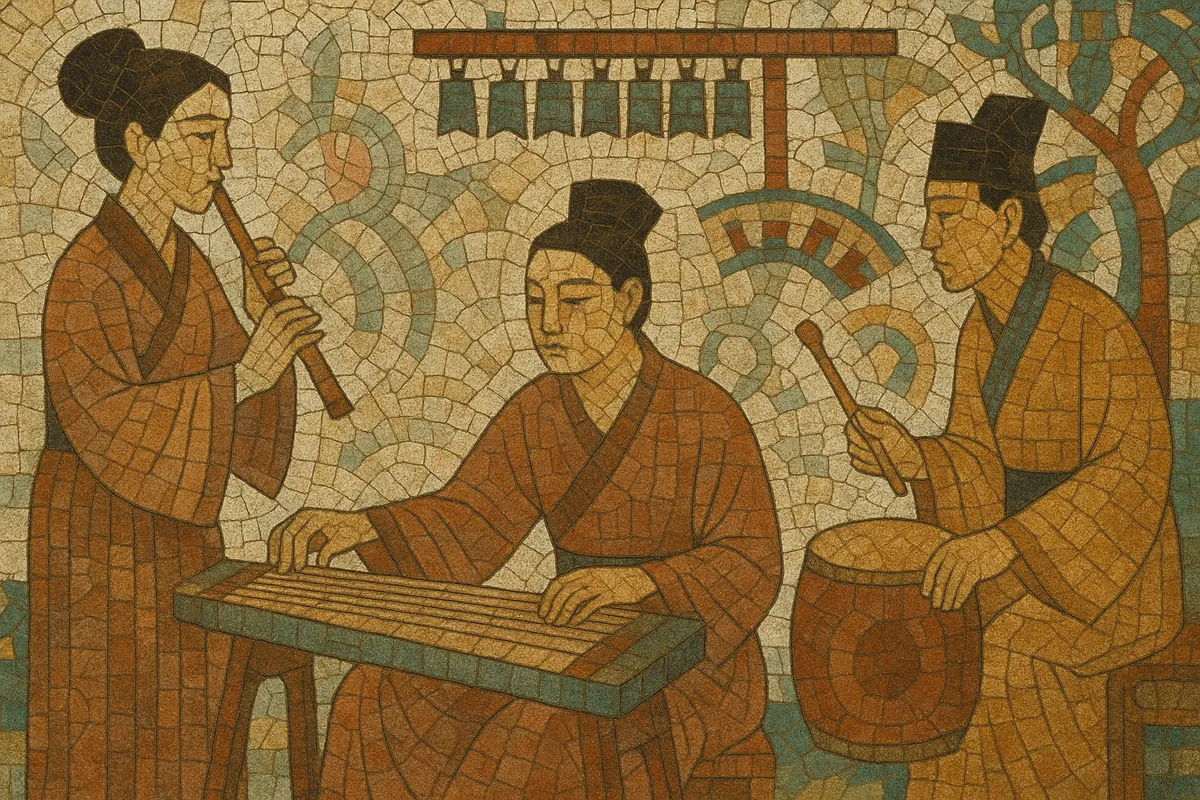Yayue (雅乐, “elegant music”) is the Confucian ceremonial and court music of ancient China, codified for state rites, ancestral worship, and courtly rituals.
It is characterized by solemn, stately tempos; pentatonic modal organization; heterophonic ensemble textures; and iconic ritual instrumentation such as bronze bell-chimes (bianzhong) and stone chimes (bianqing), alongside silk-string zithers (qin, se), bamboo flutes (xiao, di), the sheng mouth-organ, drums, and other instruments organized according to the ancient “eight sounds” (ba yin) classification.
Unlike entertainment or folk styles, Yayue functioned as moral-ritual sound, aligning music with cosmology, governance, and ethical cultivation in the Confucian order.
Yayue emerged as a formalized ritual music in the Western Zhou period (c. 1046–771 BCE), drawing on earlier court and temple practices now grouped as Ancient Chinese Music. Confucian texts (e.g., the Book of Rites, Classic of Music traditions) framed Yayue as an ethical technology: music and dance ordering the self and the state in harmony with cosmic principles. Instrumentation, pitch, and choreography were prescribed to mirror social hierarchy and cosmology.
Over centuries, Yayue practice was refined through the Twelve Lü (12 pitch-pipes) system, pentatonic modal theory (gong, shang, jue, zhi, yu), and the ba yin (eight materials) organology. Court workshops cast tuned bronze bell sets (bianzhong) and carved lithophones (bianqing), establishing the genre’s emblematic timbre. Successive dynasties (Qin–Han, Tang, Song, Ming, Qing) re-edited ritual canons, rebuilt instruments, and revised choreography (such as the eight-row dance formation, bayi), maintaining Yayue as state liturgy even as secular and operatic musics flourished.
Chinese court and ritual cultures radiated across East Asia. Elements of Yayue-informed court music and Confucian rites were adapted in Korea (aak), Japan (gagaku, particularly earlier tang-derived repertoires), and Vietnam (imperial court music traditions), where they were localized and institutionalized.
Following the fall of the imperial system, Yayue’s official role diminished. However, temple ceremonies (especially at Confucius temples) preserved core repertoires, choreographies, and instrument sets. In the late 20th and 21st centuries, museums, conservatories, and Confucius Temple administrations in mainland China and Taiwan undertook reconstructions based on archaeology, treatises, and surviving ensembles. Today Yayue is performed at state and temple ceremonies and in scholarly reconstructions, emphasizing its heritage and philosophical significance.
Use the Chinese pentatonic modal system (gong, shang, jue, zhi, yu) within the framework of the Twelve Lü pitch standards. Favor stepwise, conjunct motion and balanced, symmetrical phrases (often in 4- or 8-beat units). Reserve altered tones for structural emphasis rather than constant chromaticism.
Aim for dignified, slow to moderate tempi with steady, processional pulse. Employ heterophony: multiple instruments rendering the same melody with slight ornamental variation, converging on cadential points. Avoid showy virtuosity; clarity and unanimity take precedence.
Feature emblematic ritual timbres: bianzhong (bronze bells) and bianqing (stone chimes) for pitch and cadence markers; se and qin for sustained silk-string resonance; sheng for harmonic support and tone clusters; xiao/di flutes for lyrical lines; frame and barrel drums, nao bells, and ceremonial gongs for metric articulation. Strive for material diversity across the eight sound categories (metal, stone, silk, bamboo, gourd, earth, leather, wood).
Structure pieces in clear sections (processional introduction, main hymn, closing/coda) aligned with ritual actions (invocation, offering, recession). Coordinate with bayi dance formations where applicable: music should support measured bowing, stepping, and changes in dancer rows.
Keep embellishments restrained and codified (grace notes, slight slides on flutes and zithers, controlled vibrato on qin/se). Let bells and chimes articulate cadences and modal pillars, reinforcing solemnity and spatial grandeur.
Prioritize ensemble discipline, visual symmetry, and spatial placement (bell and chime arrays as visual-acoustic focal points). Maintain ceremonial decorum: consistent dynamics (mezzo-piano to mezzo-forte), long tone sustains, and carefully timed silences to heighten reverence.


